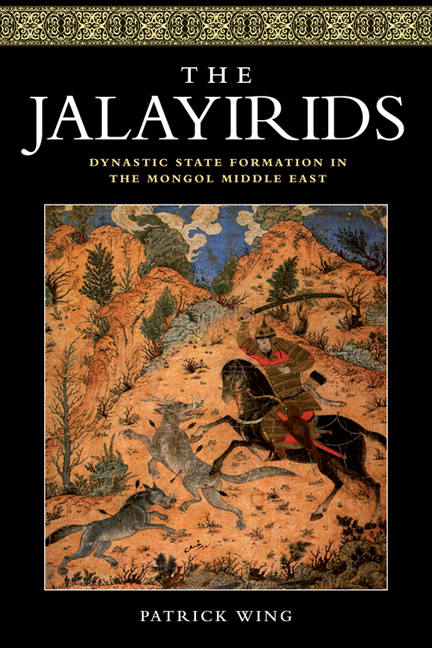Book contents
- Frontmatter
- Contents
- List of Illustrations
- Acknowledgements
- Abbreviations for Primary and Secondary Source Texts
- 1 Introduction and Sources for the History of the Jalayirids
- 2 Tribes and the Chinggisid Empire
- 3 The Jalayirs and the Early Ilkhanate
- 4 From Tribal Amirs to Royal In-laws
- 5 Crisis and Transition (1335–56)
- 6 Shaykh Uvays and the Jalayirid Dynasty
- 7 Dynastic Ideology during the Reign of Shaykh Uvays
- 8 Challenges to the Jalayirid Order
- 9 Conclusions and the Legacy of the Jalayirids
- Maps and Genealogical Chart
- Bibliography
- Index
9 - Conclusions and the Legacy of the Jalayirids
- Frontmatter
- Contents
- List of Illustrations
- Acknowledgements
- Abbreviations for Primary and Secondary Source Texts
- 1 Introduction and Sources for the History of the Jalayirids
- 2 Tribes and the Chinggisid Empire
- 3 The Jalayirs and the Early Ilkhanate
- 4 From Tribal Amirs to Royal In-laws
- 5 Crisis and Transition (1335–56)
- 6 Shaykh Uvays and the Jalayirid Dynasty
- 7 Dynastic Ideology during the Reign of Shaykh Uvays
- 8 Challenges to the Jalayirid Order
- 9 Conclusions and the Legacy of the Jalayirids
- Maps and Genealogical Chart
- Bibliography
- Index
Summary
The period of Jalayirid rule lasted only about seventy-five years in Baghdad, while Jalayirid rule in Tabriz was considerably less. The dynasty comprised only four rulers who held any considerable power, and perhaps can be understood as an irrelevant footnote to the fourteenth century, between the eras of the far more significant Ilkhanids and Timurids. Yet, an examination of the history of the Jalayirid dynasty requires an assessment of several of the most significant social and political changes in the central Islamic lands in the late medieval period. Tracing the origins of the Jalayirids and their emergence as the heirs to the Ilkhanate in the middle of the fourteenth century illuminates the complex process of politics in the context of the Mongol empire, and the relationship between the socio-political identities of tribe, ulūs and princely household.
Despite the significance of the Jalayirid period for the development of post-Mongol political identity, the legacy of the Jalayirids is perhaps most closely associated with cultural developments, particularly in the field of manuscript painting. Some of the most important changes in this distinctly Persian art form took place under the Jalayirids, bridging the masterpiece known as the Great Mongol Shāh-nāma, produced in the late Ilkhanid period, with fifteenth-and sixteenth-century Timurid and Safavid painting, commonly considered the pinnacle of the Persian miniature form. Although this study is primarily concerned with political history, considering the historical legacy of the Jalayirids without touching on their role as artistic patrons would be to ignore a central aspect of their contribution to the cultural history of Persianate society.
The fourteenth century has been characterised as the formative period of Persian painting, when the principal elements that formed later examples of painting were developed. A fundamental feature of Persian manuscript illustrations in this period was the influence from Chinese painting. In particular, Chinese-inspired landscape settings were adapted to Persian figure drawing in examples of paintings produced in Jalayirid workshops. Certainly, the Jalayirid period was important for the development of manuscript painting and the art of the book. Yet, is it accurate to speak of ‘Jalayirid painting’, and, if so, what does it mean?
- Type
- Chapter
- Information
- The JalayiridsDynastic State Formation in the Mongol Middle East, pp. 185 - 201Publisher: Edinburgh University PressPrint publication year: 2016



